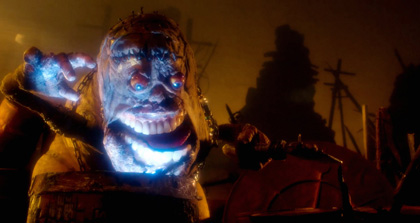

Thursday June 9, 2022 | Diablo Joe Reviews | Neal
"Mad God"
review by Diablo Joe
"Mad God"
Phil Tippet’s Mad God
“Genius.” “Visionary.” “Pioneer.” These terms are often overused. So, too, is “Labor of Love.” But the first three are arguably suitable when describing cinema effects guru Phil Tippet. When describing his 30-year stop-motion animation project, “Mad God,” available soon via streaming on Shudder, the latter is fitting, without question.

Tippet first came to the attention of film fans with his work on the first three “Star Wars” films. Tippet played a crucial part in creating some of the most iconic and memorable effects for that saga, from the holo chess pieces to the AT-AT Walkers and tauntauns. His contribution to stop-motion animation of the Go Motion technique appeared to be the next step in realism for that art until the advent of CGI changed cinema effects forever. Adapting to the new technology, Tippet helped shepherd the transition to digital with his work on “Jurassic Park,” becoming an Internet meme in the process ("One job, Phil! You had one job!").

With the apparent demotion of the labor-intensive hand-manipulated animation technique, Phil Tippet’s personal dream project, “Mad God,” which began during his work on “RoboCop II,” was sidelined for the better part of two decades. Then with the urging and assistance of his industry friends and Kickstarter support, Tippet’s nightmarishly dark ode to cinema magic has finally come to fruition. And it is something to behold.

The film follows a gas-masked Assassin, briefcase bomb in tow, into a hellscape torn asunder by war and populated by bulbous grotesques who torture and kill the tiny, more humanoid denizens of the land. The Assassin is captured, tortured, and dissected by The Last Man; he gives “birth” to a hideous squealing creature who is the fuel for a new and equally bleak cycle of worlds and existence. “Mad God” is less a film about plot and story than about ideas and evocative textures. And while many might view its narrative as thin, the movie is simply dense with ideas, visual elements, and thought-provoking themes.

Truthfully, “dense” is an understatement. “Mad God” is all devil and details. As the Assassin, like a Dante clad for the worst biohazard mishap, makes his way through this surreal, apocalyptic Inferno, Tippet fills the screen with a menagerie of horrors that don’t seem crafted by the filmmaker as much as they seem to have been excreted or expelled. They ooze and defecate, surrounded by a cabinet of curiosities for their proscenium. Peer around within this morass of details and elements as Tippet and Co. have secreted loving tributes to the history of fantastic cinema. Harryhausen creatures lurk in the shadows, as do Robby the Robot, droids, and other icons. Less subtlety hidden is Tippet’s tribute to Stanley Kubrick, an element that plays an essential part in “Mad God’s” treatment.

“Mad God” is not just filled with loving tributes to Tippet’s influences and past; it is an encyclopedia of cinematic effects magic. Pitched ostensibly as a stop-motion showcase, Tippet has left no resource unused. “Mad God” features pixelation, time-lapse, mechanical miniatures, forced perspective, digital, and even extensive use of live-action (with “Repo Man” director Alex Cox as The Last Man) in service of Tippet’s vision.

Animation has a popular reputation as a mainstay of children’s entertainment. But in the hands of filmmakers like Jan Svankmajer and The Brothers Quay, it has also worked in service of the dark, the experimental, and the terrifying (anyone who doubts this should seek out Raoul Servais’s nightmarish “Harpya.”). With “Mad God,” Tippet has re-asserted stop motion animation as one of cinema's greatest—and adult—art forms. He has also cemented his place alongside legends such as Willis O’Brien and Ray Harryhausen as one of its genuine masters.

This devil of a reviewer gives “Mad God” 4 out of 5 imps.

